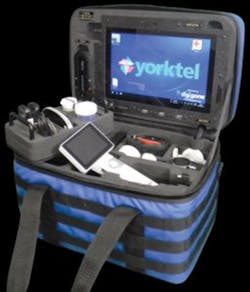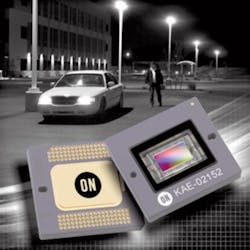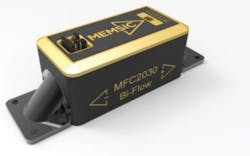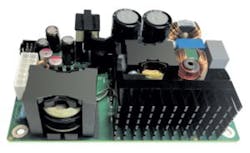This issue’s product roundup covers the gamut from components to systems for medical applications. Making news in the former category, AVX said it has added a new medical-device development facility to its corporate headquarters in Fountain Inn, SC. With more than 2,500 square feet of cleanrooms and support space for device fabrication, biological analysis, and electrical testing equipment, the new medical device development lab will accommodate the efforts of eight to 10 researchers dedicated to developing medical components.
In the latter category, Telehealth 2.0, the annual conference of the American Telemedicine Association held in April in Orlando, offered Yorktel the opportunity to unveil enhancements to its mobile telehealth kit, FeatherMed, which offers caregivers customization, flexibility, interoperability, and versatility to improve clinical workflows and provide a higher level of patient-centric care.
Some products described here are dedicated to medical applications—such as FeatherMed. Others have a broader range of applicability—for example, a power supply suitable for industrial applications that also carries a 2xMOPP (means of patient protection) rating. The application space for an image sensor described in this feature extends all the way from ophthalmology to military surveillance.
And finally, New Hampshire-based Access Sports Medicine & Orthopaedics announced it is offering virtual reality technology from appliedVR to help alleviate patients’ anxiety while they wait for medical procedures—reducing the need for antianxiety medications. Access Sports cites appliedVR case studies in which preclinical results showed a 63% reduction in anxiety, and clinical results showed a 24% decrease in pain, when patients used virtual reality. For a related video, visit https://www.youtube.com/watch?v=5bjPPqBfvzo
Portable telehealth kit
FeatherMed kits combine FDA-approved medical diagnostic tools and the vendor’s secure communication software application that integrates with any healthcare delivery system, improving the ease and efficiency of multisite collaboration between hospitals, specialists, home healthcare providers, and their patients.
For two-way video, the updated kits offer the choice of using either FeatherMed’s built-in video application with datastreaming software or a separate video client compatible with a health-delivery system’s Cisco, Polycom, Vidyo, Skype for Business, or other video platform. A new modular design allows for various configurations to match the right medical device with any clinical application. Additional accessory options are available, giving health systems the capability to custom-design their kit.
Each kit is compact, durable, lightweight, and portable, weighing 12 lb. Paired with a proprietary video-compression technology requiring bandwidth as low as 90 kb/s, FeatherMed provides the added assurance of HD, encrypted, jitter-free video for face-to-face consultations in remote situations, a critical factor in providing quality care in home health, emergency, and crisis environments as well as long-term care facilities in rural communities.
Compliant with home healthcare regulations, FeatherMed allows nurses, paramedics, and other caregivers to deliver quality, efficient care in off-site settings and to follow up with patients discharged from hospitals for whom recurring onsite visits are not practical, such as seniors, veterans, and chronically ill patients. Diagnostic tools available in the kits range from a stethoscope to a 12-lead electrocardiogram. Yorktel
Image sensors
The portfolio of Interline Transfer Electron Multiplication CCD (IT-EMCCD) image sensors has expanded with new options that target low-light industrial applications such as medical and scientific imaging as well as commercial and military applications for high-end surveillance. The new 4-Mpixel KAE-04471 uses larger 7.4-micron pixels than those found in existing IT‑EMCCD devices, doubling the light-gathering capability of the new device and improving image quality under light-starved conditions, the company said. The KAE-04471 is pin- and package-compatible with the existing 8-Mpixel KAE‑08151, allowing camera manufacturers to leverage existing camera designs to support the new device.
The new KAE-02152 shares the same 1080p resolution and 2/3-inch optical format as the existing KAE‑02150, but it incorporates an enhanced pixel design that increases sensitivity in near-infrared wavelengths—an improvement that can be critical in applications such as microscopy, ophthalmology, and surveillance. The KAE-02152 is fully drop-in compatible with the existing KAE-02150, and both devices are available in packages that incorporate an integrated thermoelectric cooler, simplifying the work required by camera manufacturers to develop a cooled camera design. ON Semiconductor
MFC2000 bidirectional digital MEMS gas-flow sensors for medical gas-flow measurement and control are durable and provide high levels of measurement repeatability when compared with existing diaphragm or turbine-based gas-flow meters. The silicon-based devices offer power-consumption characteristics such as sleep-mode currents as low as 1 µA and typical operating currents of 3 mA. Other benefits include low 2.7- to 5.5-V supply operation, wide dynamic range with 3% or better accuracy, and the capability to provide the necessary performance over a 100:1 flow range. The architecture of the mass flow sensor modules is customizable for different flow rates and form factors optimized to application requirements.
The gas-flow sensors reduce the need for specialized machines in care centers and enable gas-flow-related medical equipment to be economically introduced into the home medical market. MEMSIC, available from Mouser Electronics
250-W AC/DC supplies
The PQC250 Series wide-input-range, single-output medical/industrial power supplies deliver 250 W of output power in an industry-stand-ard open-frame 3- x 5-inch 1U footprint. The high-efficiency design can deliver full power with free-air natural convection cooling up to 50°C. The supplies feature a universal AC input voltage range from 90 to 264 VAC, 47 to 63 Hz. The convection-cooling design employs optimal thermal management and power efficiency up to 95%.
The PQC250 Series currently is available in 12-V, 24-V, 36-V, 48-V, and 54-V variants, each with a 5-V auxiliary output as a standard feature. Additional output voltage variants are under development. Featuring a remote-enable function, the PQC250 consumes less than 500 mW of power in standby mode. These power supplies can continuously deliver full output power across the temperature range from 0°C to 50°C and up to 70°C with derating.
These supplies carry medical, consumer, and ITE safety approvals and incorporate 2xMOPP isolation. With an isolation of 4,000 VAC (input to output) or 1,500 VAC (input to PE), the units are suitable for powering equipment such as ultrasound monitors, blood pressure monitors, incubators, ECG equipment, and operating tables.
Where an application requires more power or redundancy, the droop-current-share characteristic enables two or more supplies to operate in parallel to increase output current capability and flexibility. All models offer active power-factor correction and compliance to worldwide safety and EMC standards. Murata
Multilayer ceramic capacitors
The MM Series multilayer ceramic capacitors (MLCCs) are designed for use in medical devices that require significantly less parametric flexibility than commercial capacitors offer but stop short of demanding the exceptionally stringent features of fully qualified medical capacitors. The capacitors provide medical device manufacturers with consistent, cost-competitive solutions that have the design and change controls necessary to achieve FDA approvals. To further mitigate the risks already addressed by the defined designs, materials, processes, and manufacturing facilities regulated by medical-design and change controls, MM Series MLCCs also undergo internal reliability qualification, enhanced lot acceptance testing, and 100% inspection. Available in NP0 (C0G) and X7R dielectrics, eight case sizes spanning 0402 to 2220, eight rated voltages spanning 10 V to 500 V, and capacitance values spanning 0.5 pF to 1.5 μF, the MM Series MLCCs are suitable for use in a range of medical devices. AVX
Board-to-board connector
Part of the FunctionMAX connector family, the FX30B Series board-to-board connector system combines a specialized floating contact alignment with a current-carrying capability up to 25 A. Its contact design can absorb misalignment up to ±0.3 mm in the X and Y directions and +1.0 mm in the Z direction—a capability that’s beneficial when multiple connectors are used on the same PCB, as the floating mechanism offers a degree of play between the contacts during mating to ensure correct and safe mating.
The FX30B Series contact design utilizes staggered spring contacts that face each other. This design offers sufficient contact deflection in limited space, high contact reliability, and low insertion force. Each facing pair of contacts has four points of contact for increased dependability. The facing contacts also have bent leads that provide increased insulation distance in comparison to traditional straight leads.
Available in coplanar, vertical, and right-angle versions to meet a range of application requirements, the FX30B Series is offered in two, three, four, and five positions. The connector pitch is either 3.81 mm or 7.62 mm depending on amperage rating requirements. Six keys around the mating face prevent reverse insertion.
The FX30B Series is designed for use in medical-device and other applications. The connector is TÜV and UL certified. The power connector has a rated voltage of up to 250 V AC/DC, contact resistance of 2 mΩ maximum, insulation resistance of 1,000 MΩ minimum, and an operating temperature of -55°C to +105°C. Hirose Electric USA






